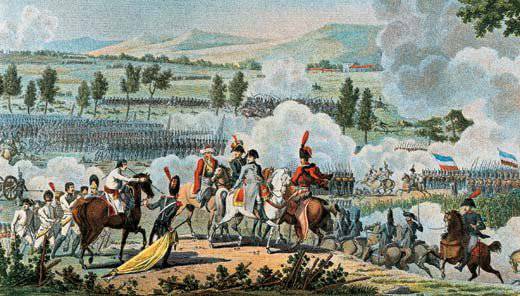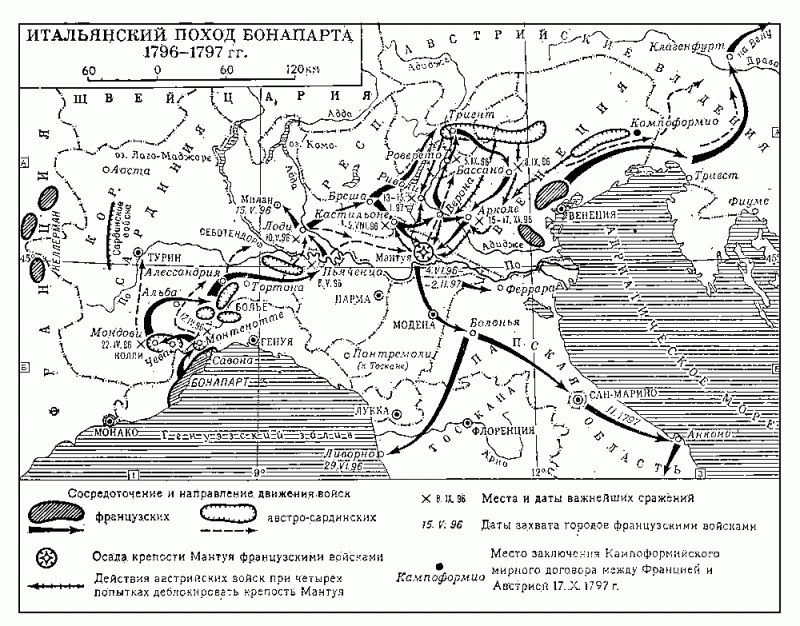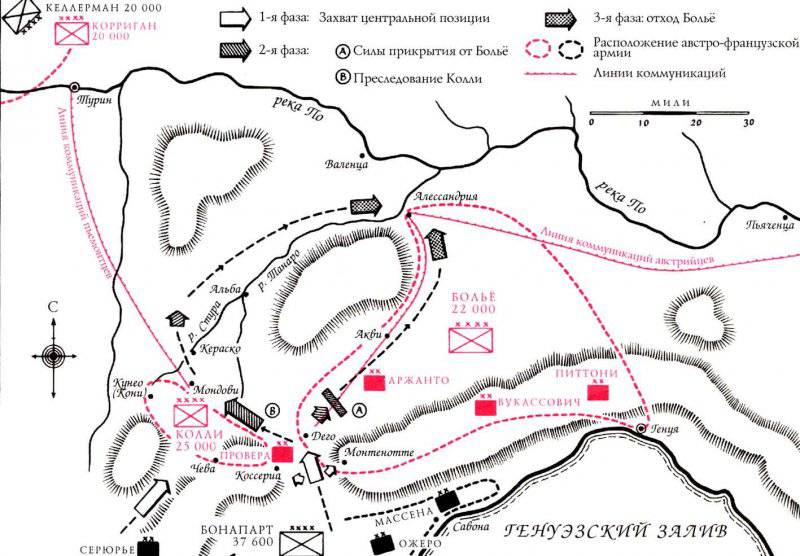"Our lineage comes from Montenotto." The first serious victory of Napoleon Bonaparte

12 April 1796 was divisional general Napoleon Bonaparte at the battle of Montenotte, scoring his first major battle victory. At that time, the future French emperor was 27 years old. The Italian campaign of 1796 - 1797 was for Napoleon Bonaparte the first military operation of a considerable scale in his life.
Napoleon dreamed of the Italian campaign, being the commander of the Paris garrison, he, together with a member of the Directorate Lazar Carnot, made plans for a campaign to Italy. On behalf of the Directory, Carnot sends a plan to the commander of the Italian army, General Scherer. But Scherer lost his temper, not wanting to be imposed on the campaign plan from above: "Let it be carried out by the one who composed it." He was caught in this - the general resigns. 2 March 1796, at the suggestion of Carnot, Napoleon was appointed commander of the Italian army. His dream came true, the general got his star chance. 11 March he went to the troops. 27 March he arrived in Nice, there was the main headquarters of the Italian army. Sherer surrendered his troops and brought up to date: 106 thousand people were in the army, but in reality there were 38 thousand, of which 8 thousand were the garrison of Nice and the coastal zone. Thus, the campaign could take no more than 25-30 thousand people. The remaining troops were "dead souls" - died, deserted, lay in hospitals, or were captured. For example, in the army there were two cavalry divisions - in both of them there were only 2,5 thousand sabers. In addition, the army was poorly supplied with ammunition, food, ammunition, salary was not paid for a long time, there were few artillery - only 30 guns. The enemy army in the Italian theater of operations numbered 80 thousand people with 200 guns. The Austro-Sardinian army was commanded by 72, the summer field marshal Beaulieu.
According to the plan of the Directory, the main role in the war were to be played by two armies under the command of Jourdan and Moreau, who operated in southern Germany. They were to defeat the Austrian troops and pave the way to Vienna. The Italian army had to play a supporting role - to divert the forces of the enemy. But Napoleon Bonaparte saw his task in a different light. Already in 1794, he had already drawn up several variants of an offensive action plan in Italy, having carefully studied the map of the future theater of military operations. His plan was generally simple. The French in Italy were opposed by two forces: the Austrian army and the army of the king of Piedmont. Napoleon wanted to defeat the Piedmontese army, and then the Austrian, smashing the enemies separately. The difficulty was in the implementation of the plan. The enemy was much stronger. To win, it was necessary to surpass the enemy in speed and maneuverability, to seize the strategic initiative in their own hands. This was not the invention of Napoleon, this tactic was used by other armies of republican France. So did Alexander Suvorov.
On the way to victory, Napoleon had to overcome other obstacles. For the experienced military generals of the Italian army (Augereau, Massena, La Harpe, and Seryurye) he was an upstart who had no experience of war with foreign armies. Napoleon moved up thanks to the suppression of rebellious French. Even before his arrival in the army, he was given a number of offensive nicknames: “Corsican intriguer”, “military from the hallway”, “General vandemier”, etc. When they saw him thin, short, casually dressed, another nickname appeared - “little pot”. In addition, the trust had to win and officers, soldiers. This could be done only by deed, military success.
5 April, the army marched. Napoleon Bonaparte chose the shortest, albeit dangerous, path along the coastal edge of the Maritime Alps. The road was narrow and completely swept from the sea. This decision allowed to bypass the mountain range and accelerated the movement. Ahead of the army, on foot, in a gray marching uniform, was the commander himself. Next to him, also in dim clothes, was Commissioner Salichetti. Napoleon’s calculation was correct, after four days the most dangerous part of the journey was over. 9 April, the French army entered Italy. The command of the Austro-Piedmont troops didn’t allow the French to decide on such impudence.
Campaign First Battle - Bivat at Montenotta
The French army invaded Northern Italy to sever the forces of the Piedmontese and the Austrians. It was the most important task - the small, hungry, loose, with a minimum of artillery and ammunition, the French army could not withstand the general battle with all the forces of the enemy. Rich Lombardy could, with success, give Napoleon the resources for a further war. It was necessary to capture Turin and Milan, to force Piedmont to break the alliance with Austria. Only victory could save the French army from destruction.
To fully implement the plan for the separation of the forces of the enemy failed. The French brigade under the command of Chervoni moved to Genoa (about 2 thousand people with 8 guns). The Austrian commander Beaulieu decided to break up parts of Chervoni, throw the French forces away from Genoa and then regroup the forces from Alessandria to strike at Napoleon’s main forces. Against the forces of Chervoni, the division of General Argento (4,5 thousand people) with the 12 guns was sent. Beaulieu had up to 20 thousand people with 40 guns.
10 April Austrian General Argento with his division approached the village of "Night Mountain" (Montenotto) and attacked the French position. He had the task of capturing Savona and cutting the Savona road (she was walking along the seashore), which led to the outskirts of Genoa. The French prepared for defense: a detachment of Colonel Rampon from the Chervoni brigade prepared three redoubts. The scouts reported the Austrian movement in time, and the French prepared for battle. Around noon 11, the Austrians rejected the advanced patrols of the French and tried to seize the fortifications. The French showed great courage and repulsed three Austrian attacks. Argento withdrew his forces in order to regroup his troops and repeat the attack the next day - striking from three sides, from the flanks and from the rear.
At this time, Beaulieu led his units to Genoa and attacked the brigade of Chervoni at the Voltri Castle. Chervoni fought back all day, then entrenched on the Mount Fourche. A strong position helped to contain the superior forces of the enemy. By the end of April 11, Chervoni retired and joined up with the LaGarp division. At the same time, Lagarp reinforced the detachment of Colonel Rampon, deploying a second line of defense behind his redoubts.
Napoleon spent the night of April 12 through the Cadibon pass of Massena and Augereau divisions. In the morning, the French forces were behind Montenotto - the Austrian division was surrounded. From the front, the soldiers of the Rampon detachment went on the attack, and the divisions Orgereau and Massena hit the flank and rear. The division was completely crushed. The Austrians lost 1 thousand people killed and 2 thousand prisoners, 5 cannons and 4 banner were captured. The French have lost 500 people killed and wounded.
It was the first victory of the Italian campaign and the first success of Napoleon as commander of the army. Napoleon Bonaparte later said: "Our lineage comes from Montenotto." The hungry, ragged soldiers of the French Republic defeated a powerful enemy. This victory was of great psychological importance. The French believed in themselves and in their commander. Beaulieu began to withdraw his forces. Napoleon could direct the main attack on the Piedmontese army.
The Austrian command was surprised, but on the whole they felt that this was an unfortunate accident. But the Austrians miscalculated. Two days later, on April 14, in the battle of Millesimo, Napoleon struck the Piedmontese army. 15 flags, 30 guns, 6 ths prisoners were captured. The Austrian and Piedmont armies were separated, the road to Milan and Turin was open. 22 April in the battle of Mondovi the French army inflicted another severe defeat on the Italians. 28 April Piedmont signed a truce on favorable terms for the French. In fact, the French became masters of Piedmont and Genoa.
The success of the campaign provided, above all, the speed and maneuverability of the French army under the leadership of Napoleon. The Austro-Piedmontese command did not expect such a pace of offensive operations from the enemy. The speed allowed Napoleon to keep the initiative in his hands and impose his will, conditions of battle on the enemy.


Information